Journal of Pediatrics, Volume 31, Issue 2, Pages 131-141. August 1947.
New York, N.Y.
Journal of Pediatrics, Volume 31, Issue 2, Pages 131-141. August 1947.
New York, N.Y.
SUPERFICIAL ulceration of the urethral meatus is a definite entity occurring in male infants and young boys, which is spite of its frequent incidence, is but little known. It occurs chiefly in circumcised children but may be found in the noncircumcised as well if the prepuce leaves the tip of the glans free to irritation.
This peculiar lesion consists of a superficial ulcer affecting the periphery of the meatus and cracking its labia to a width up to 3mm. and its depth to about the same extent. The ulcer always remains superficial and localized and never involves the deeper parts of the urethra. Urethral discharge never occurs and there is no fever. The inguinal lymph nodes are sometimes swollen and tender. Crusts may form rapidly on the surface of the ulcer and may partially or completely obstruct the meatus. This leads to difficulty in voiding and therefore is followed by urinary retention.
In many of these cases the children are unable to urinate before the obstructing crust has been removed either by pressure of overflowing urine or mechanically by parent, nurse, or physician. Voiding may be deferred forten to twelve hours.
If the orifice is obstructed by scabs, the bladder will be only incompletely emptied by a divided stream or dribbling. When the crusts come off, the first drop of urine that touches the surface of the ulcer irritates and causes intense pain. The children, therefore refuse to urinate until an overflowing bladder forces voiding. Following the passage of a few drops of urine, pain diminishes and enables the children to urinate. As soon as a scab comes off, bleeding occurs from the ulcer and bright bloody spots on the diapers or pants are frequently the first sign that alarms the parents.
Secretion on the surface of the ulcer soon starts again after the scabs have come off and new crusts are formed, causing the same difficulties and bleeding when they are removed. This vicious cycle may repeat itself many times. Eventually the ulcer heals spontaneously with resulting small constricting scars. After an interval of some time the disorder recurs and, if not treated, heals spontaneously, but again with the formation of scars and an increase of the superficial stricture. Any stricture of the urethra located in the orifice or at higher parts will eventually lead to retrograde pressure and distension with all its after-consequences of infection and pressure damage.
The disorder was first seen by J. von Bokay, Sr.1 in 1878 in twenty-three boys that were all Jewish and all circumcised. He called the lesion urethritis orificii externi.
He believed that the condition was due to poor hygiene but expressed the opinion that it may also be due to certain irritating qualities of the urine. F.R. Sturgis2 gave the first description of the entity in American literature in 1890. H. Goldenberg,3 in 1910, presented one case describing the lesion in detail, but without consideration of etiology and treatment. T. S. Southworth4 believes trauma and ammoniacal urine to be etiologic factors. J. Zahorsky,5 in a paper on diaper rash, mentions the disorder and believes the skin condition to be the essential etiologic factor. J. V. Cooke6,16 describes the condition in an article on ammonia dermatitis, and in his chapter on the same subject in Brennemanns Practice of Pediatrics. A very thorough paper on the condition was published by Brennemann7 in 1921. He believed at first that the lesion was due to the most accessible and vulnerable parts of the glans rubbing against clothing but he could not explain the extension of the ulcer into the urethra by trauma alone. Since he observed similar lesions appearing simultaneously about the diaper region in many of these cases, he agreed with Zahorsky that ammonia dermatitis
(diaper rash) should be considered the etiologic factor. In 1922, J. von Bokay, Jr.8 reported a case in which a 13-year-old noncircumcised boy, and thought that the lesion in the boy was brought about by masturbation. He also gave a list of 166 cases that were observed during a period of thirty-seven years at his hospital. Of these, thirty-eight were up to 1 year of age, ninety-four from 1 to 3 years, twenty-five from 3 to 7 years, and nine from 7 to 14 years. A. L. Wolbarst,9 in his article on stenosed urinary meatus an its treatment, saw the disorder occur when infections and inflammatory swelling further diminished an already tight meatus. He recommends meatotomy and stresses that even this operation has to be followed by dilatations for several weeks to prevent the possibility of recontraction. In 1932 M. F. Campbell10 published a case of congenital atresia of the meatus in a 7-year-old boy with pyuria and hematuria, and presented the x-ray pictures showing marked dilatation of the urethra and a hypertrophic bladder. The same author,11 in his book on pediatric urology in 1937, and in his chapter on the male reproductive system in Brennemanns Practice of Pediatrics states that he never observed a case where diaper rash alone was responsible for the condition but that only boys with a congenitally tight meatus developed the lesion. An article on coarctation of the meatus was published by B. S. Abeshouse and D. E. Bogorad12 in 1938. These authors presented thirteen cases of patients from 7 months to 7 years of age, twelve of them circumcised and mostly Jewish; one with a long pendulous foreskin leaving the tip of the glans free to irritation. They consider the ammonical urine, discussing metabolic disturbances as its reason and gastrointestinal upsets as possible etiologic agenst and are not in accord with Campbells contention that a congenitally small meatus is the chief disposing factor. W. Hofmann,13 in 1940, described a case of ulcerated meatus in a circumcised infant. In this case, however, the stenosis was not congenital but due to post-operative adhesions following the circumcision. In his paper on stenosis of the external urethral meatus, M. F. Campbell14 states, in 1943, that 98 percent of the stenosed cases are congenital. As a complication of this stenosis, ulceration occurs when and if inflammatory swelling narrows the stenosed orifice still more. After a description of the clinical criteria, he stresses the fact that, in spite of the generally accepted opinion, this disorder should not be considered as benign since urinary back pressure damages the proximal urinary tract and particularly the kidney. In sixty-three out of his 152 patients that ranged in age from 7 weeks to 16 years, urographic findings were abnormal. He recommends liberal meatotomy followed by periodic progressive dilatation
of the stenosed meatus and treats coexisting infections with urinary antiseptics.
It is astonishing how few articles on this frequent and important disorder have been written and how little the condition is known. Apart from the discussion in Brennemanns Pediatrics,15 the subject is hardly mentioned in pediatric textbooks. J. P. C. Griffith and A. G. Mitchell17 speak about an inflammation of the external orifice probably due to ammonical urine. C. Noeggerat and A. Eckstein,18 in Pfaundler and Schlossmanns Handbuch Der Kinderheilkunde, give a short description of the disorder.
Twenty-two of the twenty-five cases listed in the table were observed in the pediatric clinics of the Flower and Fifth Avenue Hospitals and the Metropolitan Hospital in New York, at regular intervals for a period of at least one and a half years. The infants were of Jewish, Irish, Italian, Puerto Rican, and Negro extraction. Three of them were breast fed (Cases 3, 10, and 18). Since relapses of the condition may occur after 5 to 8 months of symptom-free intervals, it is only possible to regard a patient as cured after a long period of observation. Therefore, sixteen more patients, ranging in age from 5½ months to 7 years, with ulcerated meatus, seen at these clinics, are not listed in this table because the mothers failed to bring them back for regular check-ups.
All of the tabled and thirteen of the non-listed cases showed a shortening of the anterior-posterior diameter of the urethral orifice to 3 mm. or less. In severe cases, only a pin-point opening could be seen. Several patients (Cases 15, 16, and 19) were seen first only with a congenital shortening of the anterior-posterior diameter and no other pathognomic signs, and later on came back to the clinic with the typical picture of an ulcerated meatus. There was first an erythema involving the tip of the glans, then small vesicles appeared at the margin of the external meatus. Their rupture left small ulcerations that eventually became confluent. They were situate at the mucocutaneous border surrounding the meatus for a diameter of 2 to 4 mm. These ulcerations were covered by a gray scrab that was so firmly adherent that its removal caused pain and bleeding. Due to these scabs, the adjacent labia of the meatus became firmly attached and obstruction was produced. Only after a certain time of obstruction the mucous membrane of the urethra became inflamed and superficial ulcerations occurred that extended to a depth of up to 3 mm.
The healing of the ulcers was rather rapid, with the formation of scars. These scars, appearing as small rhagades at the lateral urethral labia of the meatus, were readily seen later on when there was no ulceration or inflammation.
In the majority of the tabled cases and in eleven of the cases not listed, the anterior posterior diameter was not shorter than 3 mm. [Cases 1, 2, 2, 5, 6 (Fig. 5), 7 (Fig. 7), 8 Fig. 6), 9, 10, 12, 13 (Fig 3), 14 (Fig. 1), 20 (Fig. 2), 21 and 22]. In Cases 4, 15, 16, and 18, the anterior-posterior diameter of the orifice was so short that the babies had to be referred to the Urological Clinic, where successful dilatation by bougie was done. In Cases 11 (Fig. 4), 17, 19, 23, 24, and 25 (the last three observed in 1946), there was only a pinpoint opening. These caseshad to undergo meatotomy.
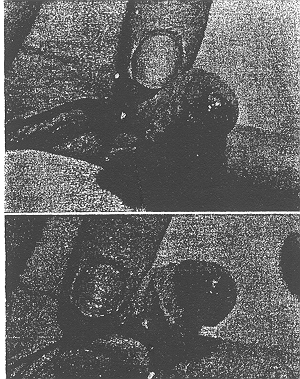
The lesion occurred usually in circumcised boys. In cases 6, 9, 10, and 24 the glans was left free to irritation by a wide pendulous foreskin. Case 9 was a boy with hypospadias and ulcerated meatus. This combination has frequently been seen by M. F. Campbell.11
In the majority of the cases, ammonia dermatitis was seen as an etiologic skin factor (Cases 1, 4, 5, 7, 8, 10, 12, 13, 15, 16, 19, 21, 22, 23, and 24). Twelve of the fifteen cases not listed showed the same condition. Faulty diet as a probable cause this dermatitis (too much orange juice, too much cream, butter, or milk) was reported by the mothers of Cases 1, 8, 15, 21, 23, and 24. Ammonia smell and high pH factors of the urine were found in a number of thesecases of diaper rash.
Six patients presented a peculiar dermatitis, which affected only the surroundings of the meatus and part of the glans. This dermatitis left the skin of the scrotum, thighs, and abdomen entirely free. It consisted of reddened areas that were slightly raised and showed a roughened surface. In none of these cases could ammonia smell from the urine ever be detected, nor was the urine pH increased. Whether a fungus or allergy was responsible for this peculiar dermatitis or whether it was due to other unknown factors could not be determined. In cases 2, 6, and 11, a typical herpes simplex of the penis was found to be the skin factor. Cultures from this orifice frequently showed Staphlyococcus albus or aureus, but this should not be considered in any way conclusive, since it is almost impossible to avoid contamination of the cultures in this area. The patients ranged in age from 3 months to 7 years. Ulceration, crust formation, difficulty and pain in voiding, and bleeding were the constant signs and symptoms.
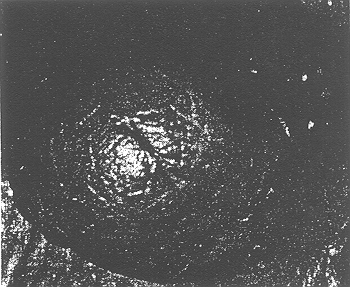
The acute condition with difficulty and pain in voiding is best treated according to Brennemanns proposal, by a drop of 2 per cent novacain solution on the surface of the ulcers, which immediately relieves pain and enables the children to urinate. The mothers are told to place the children in a warm bath which stimulates voiding and relieves pain by diluting the escaping urine. The formation of crusts after the removal of a scab can best be prevented by the frequent application of petrolatum or a 5 per cent boric acid lanolin ointment. This is, however, not sufficient in cases where reddening and swelling indicate an acute infection. Here, 5 per cent sulfathiazole ointment in lanolin base or a 5 per cent penicillin ointment have donewell.
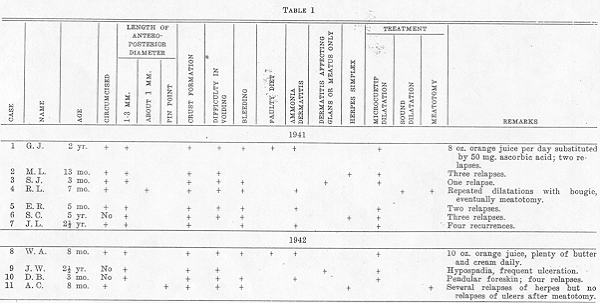
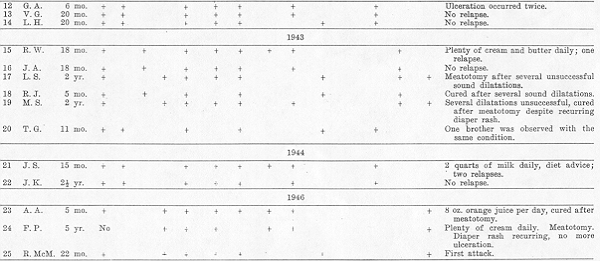
The cure of the contributing skin factor alone is insufficient as long as the anterior posterior diameter is not lengthened to its normal extent, which in children is 3 mm. or somewhat more. Wherever this has not been attained the condition will recur. In these recurring cases, especially if there are any signs of infection of the genitourinary tract, urography should be done.
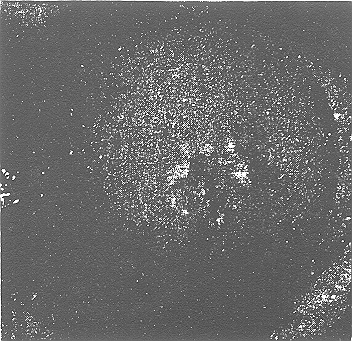

The majority the presented cases showed only a moderate shortening of this diameter and ammonia dermatitis. A method which is effective in these cases is to insert, once daily, microcuetips.
(toothpicks prepared in the manner of ear swabs with cotton projecting one-half inch beyond the tip of the tooth-pick.). The mothers were told to put the cotton end into the prescribed ointment and to insert it into the meatus to a depth of about 5 mm. once daily for a period of three months. In these cases, this treatment was sufficient to extend the anterior-posterior diameter to its normal physiological length of about 3mm. or more. In any case of ammonia dermatitis it is just as important to cure this condition and to prevent its recurrence. The diapers should be treated with a non-volatile antiseptic. This will prevent the occurrence of ammonia dermatitis. In greater degrees of shortening, bougie dilatation was done in the urological clinic and in the relatively rare cases where there was only a pinpoint opening, meatotomy had to be performed.
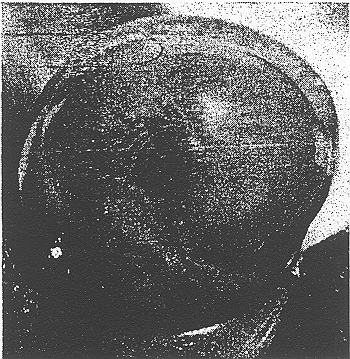
In the majority of the cases where a skin factor was ammonia dermatitis, the following steps were suggested. The diapers were washed in saturated boric acid solution instead of soap were not rinsed to obtain the best possible change of the pH from alkaline to acid. Wherever the mothers could afford it, modern neutral soaps were recommended for bathing the children. Otherwise, only boric acid solution was used for this purpose. One to two percent tar in zinc oxide paste was recommended as a protective film for the diaper regions.
As diet corrections, fruit juices were substituted by 50 mg. of ascorbic acid per day and skimmed milk was given. In the cases where the dermatitis described above involved only the periphery of the meatus or the glans and where the skin of the scrotum and thighs were intact, a protecting film with zinc oxide paste containing 3 per cent cod liver oil was found most successful. Herpes simplex dried up quickly after the application of zinc state powder as suggested by Brennemann.

Ulceration and coartation of the urethral meatus is frequently observed in clinics and private practice. Its etiology, however, is still regarded as uncertain, as the following quotations from Brennemanns textbook of pediatrics will show. Campbell, in his chapter on this subject writes: I believe that in most instances the atresia is congenital and the important predisposing factor.
Later on he states: Moreover, I have seen cases treated by local hygiene and ointments which finally required meatotomy for cure.
Brennemann, the author of this book, adds in parenthesis, It is evident that the urologist sees the ulcerated meatus under conditions that differ from those of the pediatrician… . Ulceration of the meatus in circumcised infants of the diaper age is very common. It is practically restricted to artificially fed infants from 5 to 18 months of age, and it is caused by free ammonia on the night diaper. The narrowed meatus is, here, clearly a result and not a cause of the ulceration, and in my experience has never seemed to need meatotomy.
In order to approach this problem, the urethral orifices of circumcised babies and young boys visiting the clinics was carefully checked and their anterior-posterior diameters measured. The first question that had to be answered was; What is a congenital small meatus? H. Gray,19 in his textbook on Anatomy, states that the external urethral orifice is a vertical slit bounded on either side by two small labia, its length in adults being 6 mm. The definition of a stenosis concerning this split-shaped opening is simple because it can occur in only one direction and consists of a shortening of the anterior-posterior diameter.
Careful observation of the presented cases shows that a congenital shortening of this diameter can well be differentiated for secondary constriction of the orifice, which occurs due to inflammatory scarring. The lateral labia are completely intact in congenital stenosis, and the split-shaped opening is well preserved. In secondary stenosis, there are fissures or rhagades, and in many of them there is an irregularly deformed orifice.
In none of the tabled cases was the lesion seen where the anterior-posterior diameter of the urethral opening was more than 3 mm. In one of the tabled cases (20) and in three of the non-listed children, brothers had been seen at the clinic with the same lesion. This family occurrence supports the opinion that the congenitally small meatus may be a predisposing factor of the disorder. Two patients out of the fifteen not listed, one of them 5 months, the other 8 months of age, showed a normally sized urethral orifice with an anterior-posterior diameter of more than 3mm. In these two cases the ulceration was brought about by an enormous inflammatory swelling due to ammonia dermatitis without predisposing stenosis of the meatus. The other patients not listed had diameters measuring up to 3 mm. except for two patients with a pin-point opening who had to undergo meatotomy. If, in cases of congenital stenosis, the diameter is further shortened by swelling caused by dermatitis, the disorder is likely to occur. In fifteen of the twenty-six tabled cases and in ten of the sixteen not listed, the meatus showed only a moderate degree of narrowing (1 to 3 mm. anterior-posterio diameter length). This series probably contains borderline cases of stenosis not definitely proved. However, it seems likely that even moderate stenosis constitutes a predisposing factor. Further investigations or a larger scale will be necessary to decide whether stenosis is an essential cause, or whether inflammation around the urethra, as seen in ammonia dermatitis may be the only etiologic factor.
From the Department of Pediatrics,
New York Medical College, Flower and Fifth Avenue Hospitals, and the
Metropolitan Hospital of the City of New York.
![]() Note:
Note:
![]() Note:
Note:
The Circumcision Information and Resource Pages are a not-for-profit educational resource and library. IntactiWiki hosts this website but is not responsible for the content of this site. CIRP makes documents available without charge, for informational purposes only. The contents of this site are not intended to replace the professional medical or legal advice of a licensed practitioner.
© CIRP.org 1996-2025 | Filetree | Please visit our sponsor and host:
IntactiWiki.